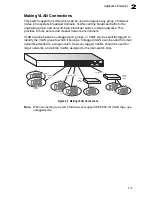
Introduction
1-2
1
Switch Architecture
The GSW-2692 employs a wire-speed, non-blocking switching fabric. This permits
simultaneous wire-speed transport of multiple packets at low latency on all ports.
The switch also features full-duplex capability on all ports, which effectively doubles
the bandwidth of each connection.
The switch uses store-and-forward switching to ensure maximum data integrity. With
store-and-forward switching, the entire packet must be received into a buffer and
checked for validity before being forwarded. This prevents errors from being
propagated throughout the network.
The switch includes built-in stacking ports that enable up to eight units to be
connected together through a 4 Gbps stack backplane. The switch stack can be
managed from a master unit using a single IP address.
Network Management Options
With a comprehensive array of LEDs, the GSW-2692 switch provides “at a glance”
monitoring of network and port status. The switch can be managed over the network
with a web browser or Telnet application, or via a direct connection to the console
port. The switch includes a built-in network management agent that allows it to be
managed in-band using SNMP or RMON (Groups 1, 2, 3, 9) protocols. It also has an
RS-232 serial port (DB-9 connector) on the front panel for out-of-band management.
A PC may be connected to this port for configuration and monitoring out-of-band via a
null-modem serial cable. (See Appendix B for wiring options.)
For a detailed description of the advanced features, refer to the Management Guide.
Description of Hardware
10BASE-T/100BASE-TX Ports
The GSW-2692 switch base unit contains 24 10BASE-T/100BASE-TX RJ-45 ports.
All ports support automatic MDI/MDI-X operation, so you can use straight-through
cables for all network connections to PCs or servers, or to other switches or hubs.
(See “10BASE-T/100BASE-TX Pin Assignments” on page B-1.)
Each of these ports support auto-negotiation, so the optimum transmission mode
(half or full duplex), and data rate (10 or 100 Mbps) can be selected automatically. If
a device connected to one of these ports does not support auto-negotiation, the
communication mode of that port can be configured manually.
Each port also supports IEEE 802.3x auto-negotiation of flow control, so the switch
can automatically prevent port buffers from becoming saturated.
Summary of Contents for GSW-2692
Page 2: ......
Page 20: ...Introduction 1 8 1...
Page 36: ...Installing the Switch 3 10 3...
Page 44: ...Making Network Connections 4 8 4...
Page 54: ...Specifications C 4 C...
Page 61: ...Index Index 3 tagging 2 5 W web based management 1 2...
Page 62: ...Index Index 4...
Page 63: ......
Page 64: ...GSW 2692 E072006 JC R01...















































